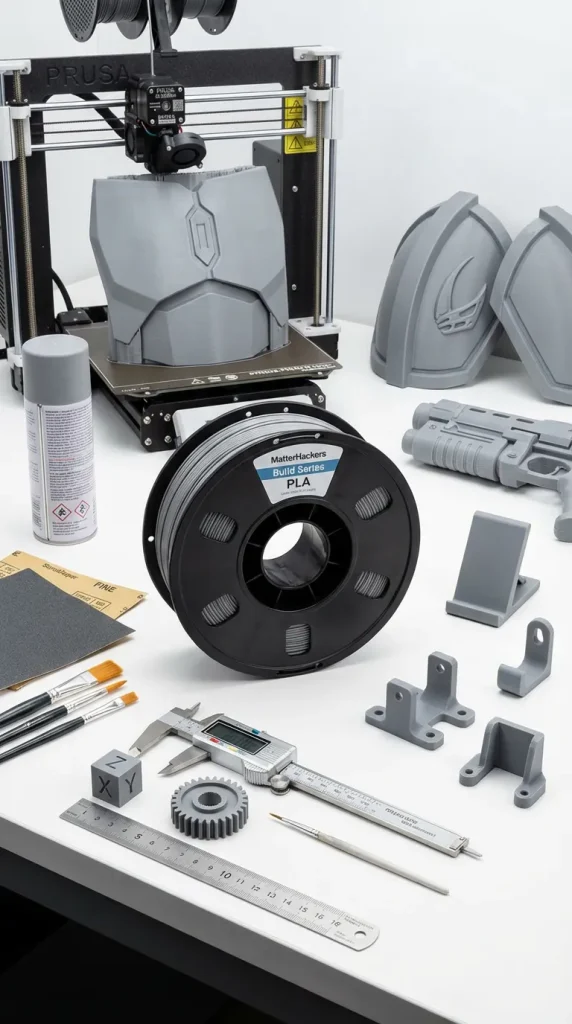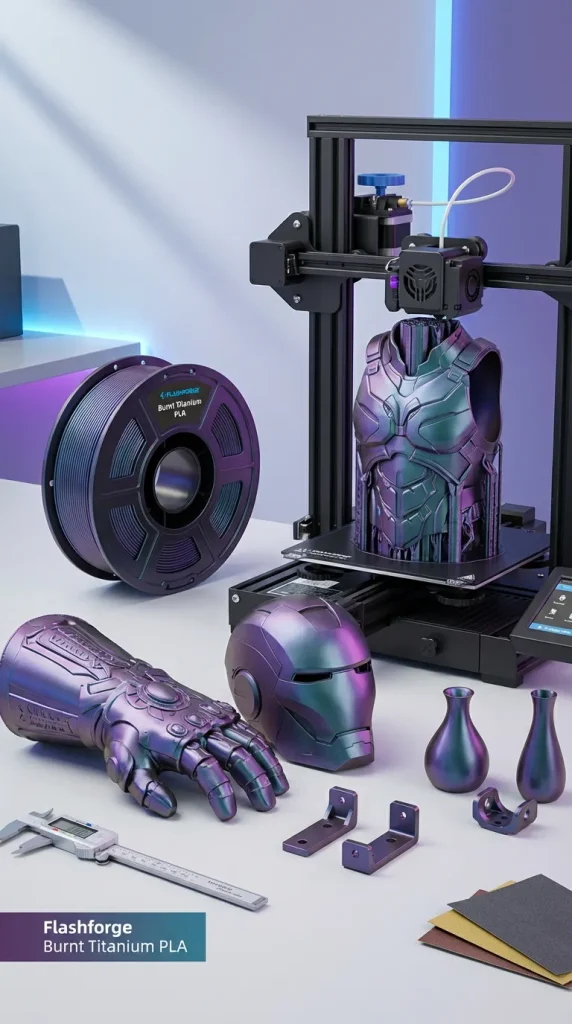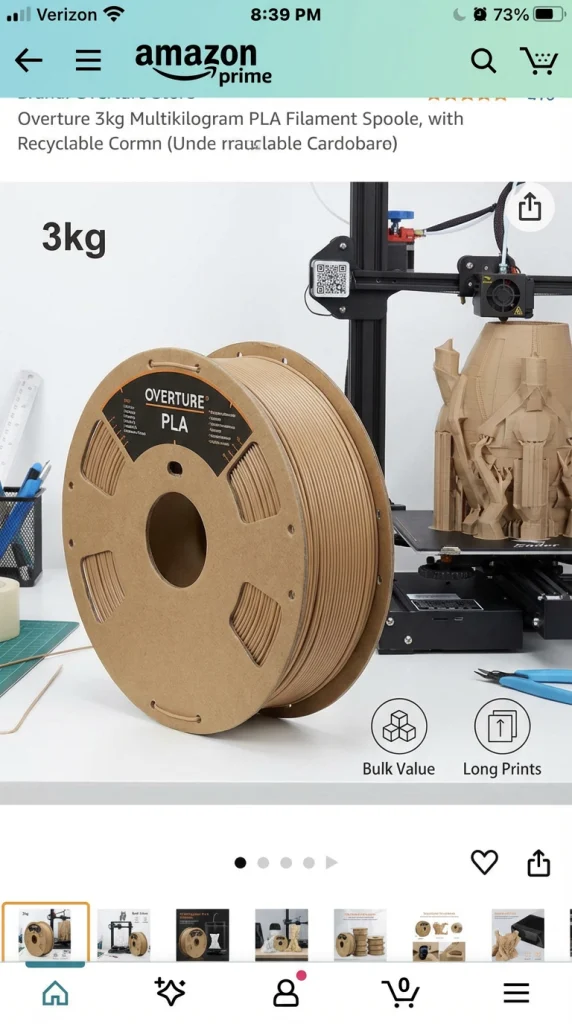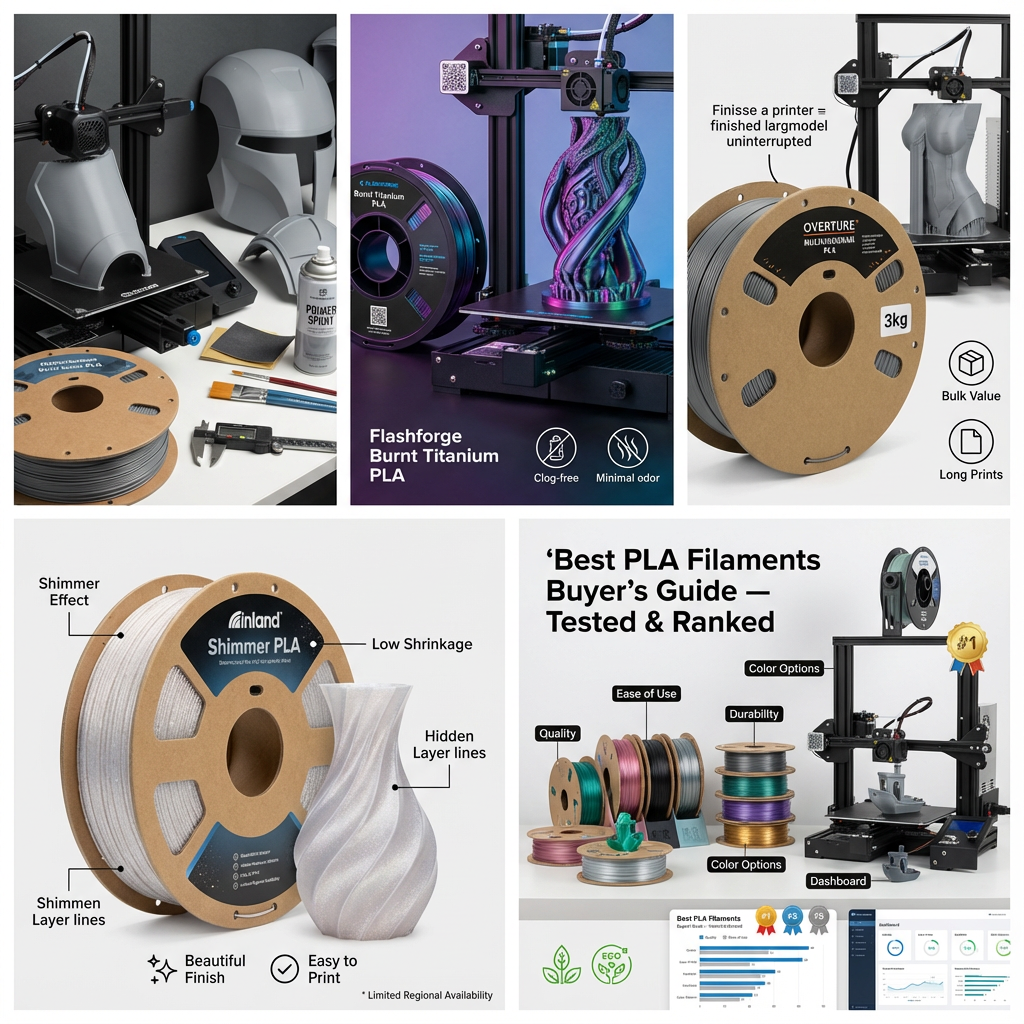Polylactic Acid (PLA) filament is a cornerstone of 3D printing, celebrated for its ease of use and versatility. Derived from renewable resources like corn starch or sugarcane, PLA is eco-friendly and emits minimal odor during printing. Its low melting point and excellent layer adhesion make it a favorite among beginners and professionals alike—qualities that also define many of the Best PLA Filaments available today.
Choosing the right PLA filament is crucial for achieving high-quality prints. The filament’s properties directly impact the strength, finish, and durability of your creations. Whether you’re crafting intricate models or functional prototypes, selecting the best filament ensures smoother printing and fewer errors.
This guide simplifies your decision-making process. We’ve tested and ranked the top PLA filaments to help you find the perfect match for your 3D printing projects. From budget-friendly options to premium picks, we’ve got you covered—and if you’re also exploring the best 3d printer for small business, we include insights to help you choose the right setup for professional use as well.

What to Look for in a PLA Filament
1. Quality
- Why It Matters: The quality of your filament directly impacts the success of your prints. Poor-quality PLA can lead to uneven extrusion, weak layer adhesion, and failed prints.
- What to Check: Look for filaments with consistent diameter tolerances (e.g., ±0.03mm). This ensures smooth feeding and reduces the risk of clogs. High-quality PLA is often made from virgin resin, which provides better consistency compared to recycled blends.
- Pro Tip: Check for certifications or reviews that highlight the filament’s reliability and performance.
2. Ease of Use
- Why It Matters: PLA is known for being user-friendly, but not all brands are created equal. Some may require more fine-tuning.
- What to Check: Choose PLA that prints well at standard temperatures (190-220°C) and adheres easily to common surfaces like painter’s tape or glass. Filaments with good flow properties minimize issues like stringing or nozzle clogs.
- Pro Tip: If you’re a beginner, opt for PLA that doesn’t require a heated bed. This simplifies the setup process.
3. Durability
- Why It Matters: While PLA is naturally rigid, its durability varies by type. Standard PLA is ideal for decorative items, but tougher variants are better for functional parts.
- What to Check: Tough PLA offers improved impact resistance and flexibility, making it suitable for projects like prototypes or mechanical parts. Look for specifications like tensile strength or impact resistance in the product details.
- Pro Tip: If you need extra durability, consider PLA blends like PLA+ or Tough PLA.
4. Color Options
- Why It Matters: The right color and finish can elevate your project’s aesthetics. PLA is available in a wide range of colors and specialty finishes.
- What to Check: Look for brands that offer consistent color quality across spools. Specialty options like silk, matte, or metallic finishes can add a unique touch to your prints.
- Pro Tip: If you’re experimenting, try sample packs to explore different colors and finishes without committing to full spools.
5. Price
- Why It Matters: Balancing cost and quality is key, especially for hobbyists or those on a budget.
- What to Check: Avoid ultra-cheap filaments, as they often compromise on quality. Mid-range options usually offer a good balance of affordability and reliability. Premium brands may cost more but often provide better consistency and fewer defects.
- Pro Tip: Watch for sales or bulk discounts to save on high-quality filaments.
Top 5 PLA Filaments (Tested & Ranked)
Finding the right material can transform your 3D printing projects. With so many options available, picking the best PLA filament can feel overwhelming. We’ve tested and ranked the top choices to help you get outstanding results every time. This guide focuses on the best PLA filaments that deliver quality, reliability, and value.
1: AnkerMake PLA+ Filament
AnkerMake PLA+ takes the top spot for its perfect blend of performance and user-friendliness. This filament is an excellent choice for a wide range of 3D printing applications, from detailed models to functional parts. It truly stands out among top PLA brands.
Key Features:
This filament is engineered for high-speed printing. It can handle speeds up to 500 mm/s without sacrificing quality. Models come out with a beautiful, glossy finish that makes colors pop. It is also made from eco-friendly materials. A very low shrinkage rate of just 0.33% ensures your prints are precise.
Pros:
- Excellent Adhesion: It sticks to the print bed incredibly well, which minimizes warping and print failures.
- Durable and Strong: The PLA+ formula offers enhanced durability over standard PLA, making your creations last.
- Non-Toxic: Being made from bio-materials, it’s a safer option for home and office environments.
- Visually Appealing: The smooth, glossy surface gives every print a professional look.
Cons:
- Slightly Higher Price: It comes at a slightly higher price point compared to budget options.
Why it’s ranked #1:
AnkerMake PLA+ is the total package. It combines incredible speed, superior print quality, and eco-conscious design. Its reliability makes it perfect for beginners who want fewer frustrations. Professionals will also appreciate the consistent, high-quality results. This balance makes it the best overall PLA filament on the market.


2: MatterHackers Build PLA
MatterHackers is a respected name in 3D printing materials, and its Build Series PLA lives up to the reputation. It is a workhorse filament designed for makers who need consistency and affordability.
Key Features:
This filament is fantastic for projects that require post-processing. It is easy to sand, prime, and paint, allowing for a perfectly smooth finish. It also boasts good dimensional accuracy, so your prints come out just as you designed them.
Pros:
- Great for Large Projects: Its reliability and affordability make it ideal for large-scale creations, such as cosplay armor or props.
- Versatile: Works well for a variety of applications, from simple models to more complex functional parts.
Cons:Limited Color Options: The color selection is not as extensive as some other brands.
3: Flashforge Burnt Titanium PLA
If you want your prints to have a unique and mesmerizing look, Flashforge Burnt Titanium PLA is a must-try. This filament creates a visual effect that helps your models stand out.
Key Features:
The most notable feature is its stunning color-shifting appearance. The filament changes between purple, blue, and green hues depending on the light. This effect does a great job of hiding layer lines. It is also very easy to print with, similar to standard PLA.
Pros:
- Visually Striking: The metallic, chameleon-like finish is gorgeous right off the printer.
- Minimal Odor: It produces very little smell during printing.
- Clog-Free Performance: Designed for a smooth and hassle-free printing experience.
Cons: Not Ideal for Painting: The unique finish is the main attraction, so you likely won’t want to paint over it.


4: Overture Multikilogram PLA
Overture is a go-to brand for many makers, known for quality and consistency. Their multikilogram PLA spools are a game-changer for anyone tired of running out of filament mid-print.
Key Features:
These filaments come on large spools, with options up to 3kg. Overture ensures a consistent diameter throughout the roll, which prevents extrusion issues. The spools themselves are made from recyclable cardboard.
Pros:
- Reduces Filament Runout: Perfect for printing huge models without needing to swap spools.
- Cost-Effective: Buying in bulk is often cheaper, making this a great value for serious printers.
Cons:
Spool Integrity: The weight of the filament can sometimes cause the cardboard spools to bend or deform.
5: Inland Shimmer PLA
For those who love a bit of sparkle, Inland Shimmer PLA delivers a beautiful finish that catches the eye. This filament adds a touch of elegance to any print.
Key Features:
Its main draw is the shimmering effect embedded in the plastic. This texture effectively hides layer lines, creating a smoother look. It also features low shrinkage, which helps prevent warping and ensures dimensional accuracy.
Pros:
- Beautiful Finish: The subtle shimmer adds a unique, attractive quality to prints.
- Easy to Print: It prints with the same ease as standard PLA, requiring no special settings.
Cons:
Regional Availability: It can sometimes be difficult to find depending on your location.

How We Tested These Filaments
To ensure reliable recommendations, we conducted thorough testing. Each filament was evaluated for print quality, ease of use, and durability. Here’s how we approached the testing:
- Print Quality:
We printed standardized models, such as Benchy and calibration cubes, to assess layer adhesion, surface finish, and dimensional accuracy. These models helped identify such problems as stringing, warping, and uneven extrusion. - Ease of Use:
Filaments were tested for compatibility with standard 3D printers, including open-frame and enclosed models. We monitored for clogs, smooth feeding, and filament adhesion to the print bed. - Durability:
Strength tests were performed using functional prints, such as carabiners. These were subjected to stress tests to measure tensile strength and flexibility. We also checked for brittleness and resistance to deformation. - Printer Compatibility:
All filaments were tested on popular 3D printers, such as the Prusa i3 MK3S and Ender 3, using a 0.4mm nozzle. Settings like temperature and speed were fine-tuned for each filament to achieve optimal results.
By following this consistent methodology, we ensured that our rankings reflect real-world performance, making it easier for you to choose the best PLA filament for your projects.
PLA Comparison Chart
| Brand | Strength | Finish | Price | Best For |
|---|---|---|---|---|
| Polymaker PLA+ | ⭐⭐⭐⭐⭐ | Matte | Medium | All-purpose |
| Overture PLA | ⭐⭐⭐⭐ | Standard | Low | Budget |
| Bambu PLA | ⭐⭐⭐⭐⭐ | Premium | Medium | Visual prints |
| Hatchbox PLA | ⭐⭐⭐⭐⭐ | Standard | Medium | Functional |
| eSun Silk PLA | ⭐⭐⭐ | Glossy | Medium | Decoration |
Tips for Choosing the Right PLA Filament
1. Match the Filament to Your Project Needs
The purpose of your project should guide your filament choice. For decorative items like vases or figurines, standard PLA is a good choice due to its smooth finish and ease of use. If you’re creating functional parts, consider tougher PLA variants that offer better durability and impact resistance. For prototypes, opt for affordable yet reliable PLA to test designs without breaking the bank.
2. Consider Your Printer’s Specifications and Settings
Not all PLA filaments are compatible with every 3D printer. Check your printer’s nozzle temperature range—most PLA requires around 200°C. A heated bed, while not mandatory, improves adhesion and reduces warping. If you’re using specialty PLA (e.g., silk or wood-filled), ensure your printer has a hardened steel nozzle to handle abrasive materials.
3. Look for Reviews and User Feedback
Before purchasing, explore reviews from other users. Feedback often highlights real-world performance, such as ease of printing, color consistency, and reliability. Look for brands with a reputation for quality and customer support. User reviews can also help you avoid filaments that are prone to clogging or yield inconsistent results.
Summery
Choosing the right PLA filament is essential for achieving high-quality 3D prints. The right filament not only enhances the visual appeal of your projects but also ensures durability and ease of use. Whether you’re a hobbyist creating decorative items or a professional working on functional prototypes, selecting a reliable filament can save you time, money, and frustration.
Our recommended brands have been tested for their performance, consistency, and value. They cater to a variety of needs, from vibrant colors to specialized finishes like silk or matte. By investing in quality filaments, you can unlock the full potential of your 3D printer and bring your creative visions to life.
Ready to elevate your 3D printing game? Explore these top-rated PLA filaments today and transform your ideas into reality with confidence!

Frequently Asked Questions
What is PLA Filament Made Of?
PLA (Polylactic Acid) filament is a thermoplastic polymer derived from renewable plant resources like corn starch, sugarcane, or cassava. These natural materials are fermented to produce lactic acid, which is then polymerized into PLA. This makes it a sustainable and biodegradable option for 3D printing.
Is PLA Filament Eco-Friendly?
Yes, PLA is considered eco-friendly because it is made from renewable resources and is biodegradable under industrial composting conditions. However, it requires specific environments to decompose effectively and may not break down in regular landfills. Additionally, its production has a lower carbon footprint than petroleum-based plastics.
How Do I Store PLA Filament?
Proper storage is essential to maintain PLA’s quality. Store it in a cool, dry place, away from direct sunlight. Use airtight containers with desiccants to prevent moisture absorption, as PLA is hygroscopic and can absorb water from the air, which may affect print quality.
Can PLA Filament Be Recycled?
PLA can be recycled, but it requires specialized facilities to process it. Mixing PLA with traditional plastics can contaminate recycling streams. Alternatively, failed prints or scraps can be composted in industrial composters, where they biodegrade into natural elements.
